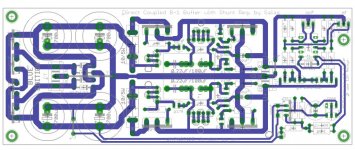Any benefir to using v rated parts in dcb1?
No, they may even cause self heating problems.
I've heard of V rated tyres for cars but never V rated components ???
He just means Violet grade (highest IDSS group in Toshiba's literature, BL is BLue) I suppose.
I can certainly measure them again with the 2SK170BL as a CCS.
The minor differences between different 2SK170s must surely be similar to the circuit that I used.
Obviously the ULTIMATE measurement must be with the particular 2SK170 that you are using with each LED string.
I suppose this is what makes this amplifier impossible to produce commercially.
The minor differences between different 2SK170s must surely be similar to the circuit that I used.
Obviously the ULTIMATE measurement must be with the particular 2SK170 that you are using with each LED string.
I suppose this is what makes this amplifier impossible to produce commercially.
Last edited:
Sorry but "Not Far", what do you mean ?
I mean its not far from real conditions. Best accuracy for finding their Vf in circuit would be to use their real K170 destined to power them in the build of course. To produce such a buffer in the way some meticulous members put it together in this thread, forget it cost wise indeed.
No, they may even cause self heating problems.
He just means Violet grade (highest IDSS group in Toshiba's literature, BL is BLue) I suppose.
Wouldnt it just amount to lower output impedance. Beimg 100% feedback already, you wouldnt get better distortion numbers, correct.
Problem is their self dissipation. Would need some special TO-92 double sink to help them and lock their drift by coupling their temp in pairs. Buffer's Zo is limited by the necessary output series resistor anyway, but the more conductance the less THD of course. Also the more Ciss unfortunately, maybe 10K pot max if like that with K170V in the audio part. Not good in the PSU part due to capacitance and drift.
Speaker manufacturers have been selecting measured components for decades.
Every driver gets measured. Every critical crossover component gets measured. The computer then "cherry picks" the combination of drivers and components to get the final speaker within that model's tolerance range.
This could easily be applied to a simple amplifier.
But is there a market for tens of thousands that the computer could send out?
Every driver gets measured. Every critical crossover component gets measured. The computer then "cherry picks" the combination of drivers and components to get the final speaker within that model's tolerance range.
This could easily be applied to a simple amplifier.
But is there a market for tens of thousands that the computer could send out?
I've just bought a batch of 2SK170BLs (16 of them) for Igs matching.
I am somewhat confused that six of them have Igs = 7mA (ish) and the remainder are 2mA (ish).
Is this normal ?
I can accurately match pairs with Igs around 2.22mA.
This is tested at 10V with G and S shorted.
I am somewhat confused that six of them have Igs = 7mA (ish) and the remainder are 2mA (ish).
Is this normal ?
I can accurately match pairs with Igs around 2.22mA.
This is tested at 10V with G and S shorted.
Idss is the current that passes when Vgs is zero (i.e. G & S shorted together) when Vds = 10V and Tj = 25degC.
A 9volt battery and room temperature is acceptable for first batching.
Use a 1r0 1% resistor as your current measuring device.
Apply 9V to 1r0+jFET
Measure the mV drop across the resistor. That is your approximate Idss.
A 9volt battery and room temperature is acceptable for first batching.
Use a 1r0 1% resistor as your current measuring device.
Apply 9V to 1r0+jFET
Measure the mV drop across the resistor. That is your approximate Idss.
To others. Just beware - these came from www.dalbani.co.uk .
I will be phoning them shortly to see what they propose to do about the fakes.
I will be phoning them shortly to see what they propose to do about the fakes.
I bought a batch of 100 from spencer and they ranged from about 6.5 t0 11. 2.2 is definitely very suspect.
Andrew, when did you start using 1R0? Isn't that a tad low? I used a 0.1% 100 ohm resistor and that seems to work quite nicely. Perhaps 100 ohms doesn't give quite enough resolution though for really close matching, a 10 ohm resistor would allow me to use the 200mV range on the multimeter rather than the 2V range... I assume this is the reason for going with such a low resistor value? Or is it because you can just use the reading without needing to divide by the resistance?
Tony.
Andrew, when did you start using 1R0? Isn't that a tad low? I used a 0.1% 100 ohm resistor and that seems to work quite nicely. Perhaps 100 ohms doesn't give quite enough resolution though for really close matching, a 10 ohm resistor would allow me to use the 200mV range on the multimeter rather than the 2V range... I assume this is the reason for going with such a low resistor value? Or is it because you can just use the reading without needing to divide by the resistance?
Tony.
Last edited:
Buzzfoorb.
I'll take you up on that offer please.
I'll let you know when I get them.
- Home
- Amplifiers
- Pass Labs
- Building a symmetrical PSU B1 buffer
